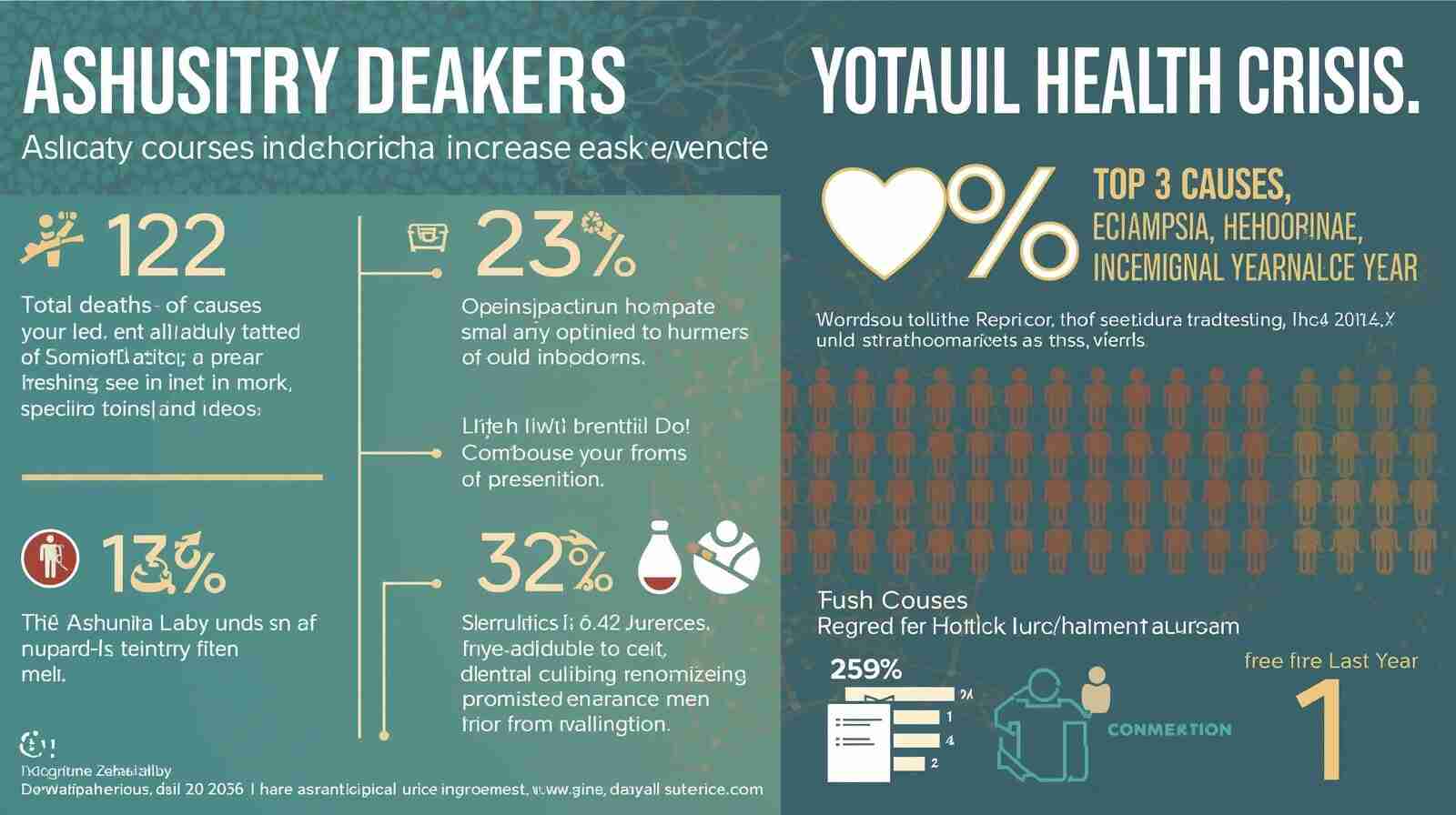Unpacking the heartbreaking statistics from Ghana’s Ashanti region and the urgent actions needed to save mothers’ lives.
A staggering 232 mothers lost their lives during childbirth or from pregnancy-related complications in Ghana's Ashanti region in just the first six months of this year. This number, released by the Ghana Health Service (GHS), translates to more than one preventable death every single day—a silent crisis that demands our immediate attention and action. This isn't just a statistic; it's a profound loss for families, communities, and the nation.
At Care and Prayer, we believe in shedding light on critical issues that shape our world. The maternal mortality rate in the Ashanti region is a pressing public health emergency that cannot be ignored.
In this in-depth report, you will gain a clear understanding of:
-
The full scope of the alarming data.
-
The primary causes behind these tragic deaths.
-
The official response from health authorities.
-
The actionable steps and solutions that could turn the tide and protect our mothers.
The Alarming Numbers: A Closer Look at the Data
The statistics are grim. According to the Ashanti Regional Health Directorate, led by Dr. Emmanuel Tinkorang, 232 mothers died between January and June of this year. This marks a devastating increase from the 195 deaths recorded during the same period last year. This 19% spike in maternal mortality signals that despite ongoing efforts, the situation is worsening.
The leading causes of death remain tragically consistent:
-
Eclampsia (pregnancy-induced seizures): 61 deaths
-
Hemorrhage (severe bleeding): 52 deaths
-
Sepsis and other infections: Also contributing significantly.
These figures underscore a critical failure in the healthcare continuum, from community-level awareness to emergency obstetric care. As we unpack these numbers, it's vital to remember that each represents a human life lost and a family forever changed.
Why Is This Happening? Root Causes of Maternal Deaths in the Ashanti Region
Understanding the "why" is the first step toward finding a solution. The crisis in the Ashanti region isn't caused by a single factor but a combination of interconnected challenges.
Critical Delays: The Three-Pronged Problem
Health experts often refer to the "three delays" model when analyzing maternal mortality, all of which are evident here:
-
Delay in Seeking Care: Pregnant women may wait too long to seek medical help due to cultural beliefs, lack of awareness of danger signs, or financial constraints.
-
Delay in Reaching a Healthcare Facility: Poor road networks, lack of transportation, and long distances to clinics or hospitals in rural parts of the Ashanti region can be fatal.
-
Delay in Receiving Adequate Care at the Facility: Once a woman reaches a hospital, she may face delays due to staff shortages, lack of essential supplies (like blood), or inadequate equipment for emergency procedures.

Systemic Failures within the Healthcare Infrastructure
The healthcare system itself is under immense pressure. Hospitals and clinics in the Ashanti region often grapple with:
-
Overcrowding: Leading to rushed care and exhausted medical staff.
-
Resource Shortages: A lack of available beds in intensive care units (ICUs) and a shortage of blood for transfusions are frequently cited issues.
-
Staffing Gaps: Not enough trained midwives, nurses, and doctors, particularly specialists like anesthetists and obstetricians, to manage high-risk pregnancies.
These systemic issues create a dangerous environment where preventable complications become life-threatening emergencies.
The Silent Threat of Underlying Health Conditions
Many women enter pregnancy with undiagnosed or poorly managed conditions like hypertension. When the strain of pregnancy is added, these conditions can escalate into deadly complications like eclampsia. Insufficient and inconsistent antenatal care means these risks are often not identified until it's too late.The Official Response: What Are Health Authorities Doing?
In response to the escalating crisis, the Ashanti Regional Health Directorate has publicly acknowledged the problem and is focusing on several key areas. Dr. Tinkorang has emphasized the need for a "no-mother-should-die-while-giving-birth" approach.
Initiatives include:
-
Enhanced Monitoring: Stricter audits of every maternal death to identify specific failures and prevent recurrence.
-
Public Education Campaigns: Increasing awareness about the importance of early antenatal care and recognizing danger signs.
-
Strengthening Referral Systems: Improving coordination between local clinics and major hospitals to ensure faster, more efficient transfers for high-risk patients.

The Path Forward: A Collective Call to Action to Protect Mothers
This is not a problem that health authorities can solve alone. It requires a concerted effort from government, communities, and individuals.Empowering Communities Through Education
Knowledge is power. Community leaders, local radio stations, and family heads must champion the cause of safe motherhood. Education on topics like family planning, nutrition during pregnancy, and the importance of skilled birth attendants can save lives. This could be part of a broader look at Finn Wolfhard's Brave Battle with Anxiety: What the Stranger Things Star Wants You to KnowStrengthening Antenatal and Postnatal Care
Regular, high-quality antenatal care is the most effective tool for identifying risks early. This means ensuring clinics are well-stocked, staffed by trained professionals, and accessible to all, regardless of their location or ability to pay. Postnatal care is equally crucial for identifying issues like postpartum hemorrhage or infection.Investment and Accountability in Healthcare
Ultimately, saving mothers' lives requires investment. The government and its partners must allocate more resources to the healthcare infrastructure in the Ashanti region—and across Ghana. This means more hospital beds, a stable blood supply, better equipment, and fair compensation for healthcare workers.2. What are the leading causes of these maternal deaths?
The top three identified causes of maternal death in the Ashanti region are eclampsia (seizures caused by high blood pressure), hemorrhage (severe bleeding), and infections like sepsis.
3. Why is maternal mortality increasing in the Ashanti region?
The increase is attributed to a combination of factors, including delays in seeking and receiving medical care, shortages of medical supplies like blood, lack of sufficient ICU beds, and underlying health issues in pregnant women.
4. What is the Ghana Health Service doing about the situation?
The GHS is implementing stricter maternal death audits, launching public education campaigns to encourage early medical care, and working to improve the patient referral system between smaller clinics and larger hospitals in the Ashanti region.
5. How can ordinary citizens help address this crisis?
Citizens can help by raising awareness, donating blood, supporting NGOs that work in maternal health, and participating in community discussions that encourage pregnant women to attend regular antenatal check-ups and deliver at health facilities.
Through a combined effort of government investment, healthcare system reform, community education, and individual responsibility, we can and must create a future where no mother in the Ashanti region, or anywhere else, dies while giving life.
What are your thoughts on this crisis? Share this article to raise awareness, and let us know in the comments what solutions you believe are most critical.
The Care and Prayer Team is a collective of journalists, researchers, and storytellers dedicated to providing clear, in-depth, and impactful analysis of the events shaping our world. We believe in the power of information to inspire change.
